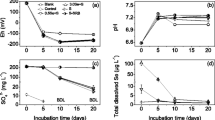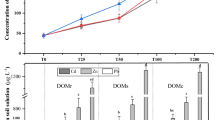Abstract
The dynamic change of redox conditions is a key factor in emission of elemental mercury (Hg0) from riparian soils. The objective of this study was to elucidate the influences of redox conditions on Hg0 emission from riparian soils. Soil suspension experiments were conducted to measure Hg0 emission from five Hg-contaminated soil samples in two redox conditions (i.e., treated with air or with N2). In four of the five samples, Hg0 emission was higher in air treatment than on N2 treatment. Remaining one soil, which has higher organic matter than other soils, showed no distinct difference in Hg0 production between air and N2 treatment. In soil suspensions subject to N2 treatment, the dissolved organic carbon (DOC) and Fe2+ concentrations were 3.38- to 1.34-fold and 1.44- to 2.28-fold higher than those in air treatment, respectively. Positive correlations were also found between the DOC and Fe2+ (r = 0.911, p < 0.01) and Hg2+ (r = 0.815, p < 0.01) concentrations in soil solutions, suggesting Fe2+ formation led to the release of DOC, which bound to Hg2+ in the soil and, in turn, limited the availability of Hg2+ for reduction to Hg0 in N2 treatment. On the other hand, for remaining one soil, more Hg2+ might be adsorbed onto the DOM in the air treatment, resulted in the inhibition of Hg0 production in air treatment. These results imply that the organic matter is important to prevent Hg0 production by changing redox condition. Further study is needed to prove the role of organic matter in the production of Hg0.





Similar content being viewed by others
Data Availability
The data that support the findings of this study are available on request from the corresponding author, [Shohei Riya], upon reasonable request.
References
Arcagni M, Juncos R, Rizzo A et al (2018) Species- and habitat-specific bioaccumulation of total mercury and methylmercury in the food web of a deep oligotrophic lake. Sci Total Environ 612:1311–1319. https://doi.org/10.1016/j.scitotenv.2017.08.260
Bone SE, Bargar RJ, Sposito G (2014) Mackinawite (FeS) reduces mercury(II) under sulfidic conditions. Environ Sci Technol 48:10681–10689. https://doi.org/10.1021/es501514r
Bouffard A, Amyot M (2009) Importance of elemental mercury in lake sediments. Chemosphere 74:1098–1103. https://doi.org/10.1016/j.chemosphere.2008.10.045
Cizdziel JV, Jiang Y, Nallamothu D et al (2019) Air/surface exchange of gaseous elemental mercury at different landscapes in Mississippi. USA. https://doi.org/10.3390/atmos10090538
During A, Rinklebe J, Böhme F et al (2009) Mercury volatilization from three floodplain soils at the central Elbe River, Germany. Soil Sediment Contam 18:429–444. https://doi.org/10.1080/15320380902962395
Gu B, Bian Y, Miller CL et al (2011) Mercury reduction and complexation by natural organic matter in anoxic environments. Proc Natl Acad Sci U S A 108:1479–1483. https://doi.org/10.1073/pnas.1008747108
Haitzer M, Aiken RG, G, NJ Ryan, (2002) Binding of mercury(II) to dissolved organic matter: the role of the mercury-to-DOM concentration ratio. Environ Sci Technol 36:3564–3570. https://doi.org/10.1021/es025699i
Jeremiason JD, Portner JC, Aiken GR et al (2015) Photoreduction of Hg(II) and photodemethylation of methylmercury: the key role of thiol sites on dissolved organic matter. Environ Sci Process Impacts 17:1892–1903. https://doi.org/10.1039/c5em00305a
Jiskra M, Wiederhold GJ, Skyllberg U et al (2015) Mercury deposition and re-emission pathways in boreal forest soils investigated with hg Isotope signatures. Environ Sci Technol 49:7188–7196. https://doi.org/10.1021/acs.est.5b00742
Kentisbeer J, Leeson SR, Malcolm HM et al (2014) Patterns and source analysis for atmospheric mercury at Auchencorth Moss, Scotland. Environ Sci : Processes Impacts 16:1112–1123. https://doi.org/10.1039/C3EM00700F
Khwaja AR, Bloom PR, Brezonik PL (2006) Binding constants of divalent mercury (Hg2+) in soil humic acids and soil organic matter. Environ Sci Technol 40:844–849. https://doi.org/10.1021/es051085c
Knorr KH (2013) DOC-dynamics in a small headwater catchment as driven by redox fluctuations and hydrological flow paths - are DOC exports mediated by iron reduction/oxidation cycles? Biogeosciences 10:891–904. https://doi.org/10.5194/bg-10-891-2013
Li P, Feng XB, Qiu GL et al (2009) Mercury pollution in Asia: a review of the contaminated sites. J Hazard Mater 168:591–601. https://doi.org/10.1016/J.JHAZMAT.2009.03.031
Magarelli G, Fostier AH (2005) Influence of deforestation on the mercury air/soil exchange in the Negro River Basin, Amazon. Atmos Environ 39:7518–7528. https://doi.org/10.1016/J.ATMOSENV.2005.07.067
Mbanga O, Ncube S, Tutu H, et al (2019) Mercury accumulation and biotransportation in wetland biota affected by gold mining. Environ Monit Assess 191. https://doi.org/10.1007/s10661-019-7329-z
Moore CW, Castro MS (2012) Investigation of factors affecting gaseous mercury concentrations in soils. Sci Total Environ 419:136–143. https://doi.org/10.1016/j.scitotenv.2011.12.068
Obrist D, Faïn X, Berger C (2010) Gaseous elemental mercury emissions and CO2 respiration rates in terrestrial soils under controlled aerobic and anaerobic laboratory conditions. Sci Total Environ 408:1691–1700. https://doi.org/10.1016/J.SCITOTENV.2009.12.008
Obrist D, Kirk JL, Zhang L et al (2018) A review of global environmental mercury processes in response to human and natural perturbations: changes of emissions, climate, and land use. Ambio 47:116–140. https://doi.org/10.1007/s13280-017-1004-9
Oste LA, Temminghoff JME, Van Riemsdijk HW (2001) Solid-solution partitioning of organic matter in soils as influenced by an increase in pH or Ca concentration. Environ Sci & Technol 36:208–214. https://doi.org/10.1021/es0100571
Pan W, Kan J, Inamdar S et al (2016) Dissimilatory microbial iron reduction release DOC (dissolved organic carbon) from carbon-ferrihydrite association. Soil Biol Biochem 103:232–240. https://doi.org/10.1016/j.soilbio.2016.08.026
Pang J, Han J, Fan X et al (2019) Mercury speciation, bioavailability and risk assessment on soil–rice systems from a watershed impacted by abandoned Hg mine-waste tailings. Acta Geochim 38:391–403. https://doi.org/10.1007/s11631-018-0305-4
Peretyazhko T, Sposito G (2005) Iron (III) reduction and phosphorous solubilization in humid tropical forest soils. Geochim Cosmochim Acta 69:3643–3652. https://doi.org/10.1016/j.gca.2005.03.045
Poissant L, Pilote M, Constant P et al (2004) Mercury gas exchanges over selected bare soil and flooded sites in the bay St. François wetlands (Québec, Canada). Atmos Environ 38:4205–4214. https://doi.org/10.1016/J.ATMOSENV.2004.03.068
Poissant L, Pilote M, Beauvais C et al (2005) A year of continuous measurements of three atmospheric mercury species (GEM, RGM and Hgp) in southern Québec, Canada. Atmos Environ 39:1275–1287. https://doi.org/10.1016/J.ATMOSENV.2004.11.007
Renneberg AJ, Dudas MJ (2001) Transformations of elemental mercury to inorganic and organic forms in mercury and hydrocarbon co-contaminated soils. Chemosphere 45:1103–1109. https://doi.org/10.1016/S0045-6535(01)00122-9
Rimondi V, Costagliola P, Lattanzi P et al (2019) A 200 km-long mercury contamination of the Paglia and Tiber floodplain: monitoring results and implications for environmental management. Environ Pollut 255:113191. https://doi.org/10.1016/j.envpol.2019.113191
Rinklebe J, During A, Overesch M et al (2010) Dynamics of mercury fluxes and their controlling factors in large Hg-polluted floodplain areas. Environ Pollut 158:308–318. https://doi.org/10.1016/J.ENVPOL.2009.07.001
Salimi S, Almuktar SAAAN, Scholz M (2021) Impact of climate change on wetland ecosystems: a critical review of experimental wetlands. J Environ Manage 286:112160. https://doi.org/10.1016/j.jenvman.2021.112160
Schroeder WH, Munthes J (1998) Atmospheric mercury—an overview. Atmos Environ. 32(5):809–822. https://doi.org/10.1016/S1352-2310(97)00293-8
Siciliano SD, O’Driscoll JN, Lean RSD (2002) Microbial reduction and oxidation of mercury in freshwater lakes. Environ Sci Technol 36:3064–3068. https://doi.org/10.1021/es010774v
Skyllberg U, Xia K, Bloom PR et al (2000) Binding of mercury (II) to reduced sulfur in soil organic matter along upland-peat soil transects. J Environ Qual 29:855–865. https://doi.org/10.2134/jeq2000.00472425002900030022x
Tang Z, Fan F, Deng S, Wang D (2020) Mercury in rice paddy fields and how does some agricultural activities affect the translocation and transformation of mercury - a critical review. Ecotoxicol Environ Saf 202:110950. https://doi.org/10.1016/j.ecoenv.2020.110950
Wang Z, Fei Z, Wu Q, Yin R (2020) Evaluation of the effects of Hg/DOC ratios on the reduction of Hg (II) in lake water. Chemosphere 253:126634. https://doi.org/10.1016/J.CHEMOSPHERE.2020.126634
Weiss JV, Emerson D, Backer SM, Megonigal JP (2003) Enumeration of Fe (II)-oxidizing and Fe (III)-reducing bacteria in the root zone of wetland plants: implications for a rhizosphere iron cycle. Biogeochemistry 64:77–96. https://doi.org/10.1023/A:1024953027726
Zhang H, Lindberg SE (1999) Processes influencing the emission of mercury from soils: A conceptual model. J Geophys Res-Atmos 104(D17):21889–21896. https://doi.org/10.1029/1999JD900194
Zhang H, Lindberg SE, Marsik FJ, Keeler GJ (2001) Mercury air/surface exchange kinetics of background soils of the Tahquamenon River watershed in the Michigan Upper Peninsula. Water Air Soil Pollut 126:151–169. https://doi.org/10.1023/A:1005227802306
Zhang X, Guo Y, Liu G et al (2021) Dark reduction of mercury by microalgae-associated aerobic bacteria in marine environments. Environ Sci Technol 55:14258–14268. https://doi.org/10.1021/acs.est.1c03608
Zhu J, Wang D, Liu X, Zhang Y (2011) Mercury fluxes from air/surface interfaces in paddy field and dry land. Appl Geochemistry 26:249–255. https://doi.org/10.1016/J.APGEOCHEM.2010.11.025
Zhu W, Song Y, Adediran GA et al (2018) Mercury transformations in resuspended contaminated sediment controlled by redox conditions, chemical speciation and sources of organic matter. Geochim Cosmochim Acta 220:158–179. https://doi.org/10.1016/J.GCA.2017.09.045
Acknowledgements
We thank Edanz (https://jp.edanz.com/ac) for editing a draft of this manuscript.
Funding
This work was supported by the Environment Research and Technology Development Fund (grant number 5–1905) of the Ministry of the Environment, Japan.
Author information
Authors and Affiliations
Contributions
Shuting Zhao, Akihiko Terada, Makoto Nakashima, Takeshi Komai, and Shohei Riya conceived and planned the experiments. Shuting Zhao and Shohei Riya carried out the experiments. Masaaki Hosomi, Makoto Nakashima, Hong Hou, and Takeshi Komai contributed to sample preparation. Shuting Zhao, Akihiko Terada, and Shohei Riya contributed to the interpretation of the results. Shohei Riya took the lead in writing the manuscript.
Corresponding author
Ethics declarations
Ethical approval
Not applicable.
Consent to participate
Not applicable.
Consent for publication
All authors agree and approved current version of the manuscript.
Competing interests
The authors declare no competing interests.
Additional information
Responsible Editor: Kitae Baek
Publisher's Note
Springer Nature remains neutral with regard to jurisdictional claims in published maps and institutional affiliations.
Rights and permissions
Springer Nature or its licensor (e.g. a society or other partner) holds exclusive rights to this article under a publishing agreement with the author(s) or other rightsholder(s); author self-archiving of the accepted manuscript version of this article is solely governed by the terms of such publishing agreement and applicable law.
About this article
Cite this article
Zhao, S., Terada, A., Nakashima, M. et al. Elemental mercury production from contaminated riparian soil suspensions under air and nitrogen bubbling conditions. Environ Sci Pollut Res (2024). https://doi.org/10.1007/s11356-024-33384-w
Received:
Accepted:
Published:
DOI: https://doi.org/10.1007/s11356-024-33384-w




